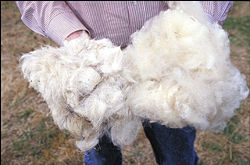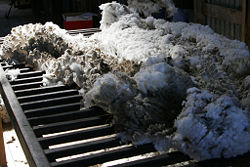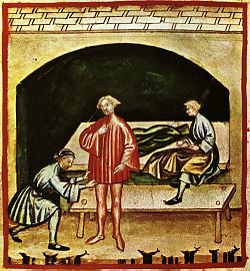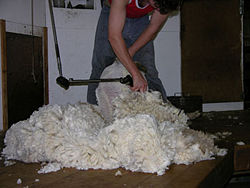Wool
- This article is about wool, the fibre commonly produced from sheep. For alternative meanings see Wool (disambiguation).
- See Alpaca wool, Angora wool (of rabbits) and Cashmere wool (of goats) for information about other wools. See Cotton wool and Steel wool for other fibres including the word wool in their common name.
Wool is the fiber derived from the fur of animals of the Caprinae family, principally sheep, but the hair of certain species of other mammals such as goats, alpacas, llamas and rabbits may also be called wool. This article deals explicitly with the wool produced from domestic sheep.
Wool has two qualities that distinguish it from hair or fur: it has scales which overlap like shingles on a roof and it is crimped; in some fleeces the wool fibres have more than 20 bends per inch.
Characteristics
Wool's scaling and crimp make it easier to spin and felt the fleece. They help the individual fibres attach to each other so that they stay together. Because of the crimp, wool fabrics have a greater bulk than other textiles and retain air, which causes the product to retain heat. Insulation also works both ways; bedouins and tuaregs use wool clothes to keep the heat out.
The amount of crimp corresponds to the thickness of the wool fibres. A fine wool like merino may have up to a hundred crimps per inch, while the coarser wools like karakul may have as few as one to two crimps per inch.
Hair, by contrast, has little if any scale and no crimp and little ability to bind into yarn. On sheep, the hair part of the fleece is called kemp. The relative amounts of kemp to wool vary from breed to breed, and make some fleeces more desirable for spinning, felting or carding into batts for quilts or other insulating products.
Wool is generally a creamy white colour, although some breeds of sheep produce natural colors such as black, brown and gray.
Processing
Wool straight off a sheep contains a high level of grease which contains valuable lanolin, as well as dirt, dead skin, sweat residue, and vegetable matter. This state is known as "grease wool" or "wool in the grease". Before the wool can be used for commercial purposes it must be scoured, or cleaned. Scouring may be as simple as a bath in warm water, or a complicated industrial process using detergent and alkali. [1] In commercial wool, vegetable matter is often removed by the chemical process of chemical carbonization[2]. In less processed wools, vegetable matter may be removed by hand, and some of the lanolin left intact through use of gentler detergents. This semi-grease wool can be worked into yarn and knitted into particularly water-resistant mittens or sweaters, such as those of the Aran Island fishermen. Lanolin removed from wool is widely used in the cosmetics industry.
After shearing, the wool is separated into five main categories: fleece (which makes up the vast bulk), pieces, bellies, crutchings and locks. The latter four are packaged and sold separately. The quality of fleece is determined by a technique known as wool classing, whereby a qualified woolclasser tries to group wools of similar gradings together to maximise the return for the farmer or sheep owner.
Quality
The quality of wool is determined by the following factors, fiber fineness, length, scale structure, color, cleanliness, and freedom from damage[3]. For example merino wool is typically 3-5 inches in length and is very fine (between 12-24 microns[4]). Wool taken from sheep produced for meat is typically more coarse, and has fibers are 1.5 to 6 inches in length. Damage or "breaks in the wool" can occur if the sheep is stressed while it is growing its fleece, resulting in a thin spot where the fleece is likely to break.[5]
Wool is also separated into grades based on the measurement of the wool's diameter in microns. These grades may vary depending on the breed or purpose of the wool. For example:
- < 17.5 - Ultrafine merino
- 17.6-18.5 - Superfine merino
- < 19.5 - Fine merino
- 19.6-20.5 - Fine medium merino
- 20.6-22.5 - Medium merino
- 22.6 < - Strong merino [4]
or
- < 24.5 - Fine
- 24.5–31.4 - Medium
- 31.5-35.4 - Fine crossbred
- 35.5 < - coarse crossbred[6]
In general, anything smaller than 25 microns can be used for garments, while coarser grades are used for outerwear or rugs. The finer the wool, the softer it will be, while coarser grades are more durable and less prone to pilling.
History
As the raw material has been readily available since the widespread domestication of sheep—and of goats, the other provider of wool— the use of felted or woven wool for clothing and other fabrics characterizes some of the earliest civilizations. Prior to invention of shears - probably in the Iron Age - the wool was plucked out by hand or by bronze combs. The oldest European woollen textile, of ca. 1500 B.C.E., was preserved in a Danish bog [1].
In Roman times, wool, linen and leather clothed the European population: the cotton of India was a curiosity that only naturalists had heard of, and silk, imported along the Silk Road from China, was an extravagant luxury. Pliny's Natural History records a Roman reputation for producing the finest wool was enjoyed by Tarentum, where selective breeding had produced sheep with a superior fleece, but which required special care.
In medieval times, as trade connections expanded, the Champagne fairs revolved around the production of woollen cloth in small centers such as Provins; the network that the sequence of annual fairs developed meant that the woollens of Provins might find their way to Naples, Sicily, Cyprus, Majorca, Spain and even Constantinople (Braudel, 316). The wool trade developed into serious business, the generator of capital. In the thirteenth century, the wool trade was the economic engine of the Low Countries and of Central Italy; by the end of the following century Italy predominated, though in the 16th century Italian production turned to silk (Braudel p 312). Both pre-industries were based on English raw wool exports— rivalled only by the sheepwalks of Castile, developed from the fifteenth century— which were a significant source of income to the English crown, which from 1275 imposed an export tax on wool called the "Great Custom". Economies of scale were instituted in the Cistercian houses, which had accumulated great tracts of land during the twelfth and early thirteenth centuries, when land prices were low and labour still scarce. Raw wool was baled and shipped from North Sea ports to the textile cities of Flanders, notably Ypres and Ghent, where it was dyed and worked up as cloth. At the time of the Black Death, English textile industries accounted for about 10% of English wool production (Cantor 2001, 64); the English textile trade grew during the fifteenth century, to the point where export of wool was discouraged. Over the centuries, various British laws controlled the wool trade or required the use of wool even in burials. The smuggling of wool out of the country, known as owling, was at one time punishable by the cutting off of a hand. After the Restoration, fine English woollens began to compete with silks in the international market, partly aided by the Navigation Acts; in 1699 English crown forbade its American colonies to trade wool with anyone else but England itself.
A great deal of the value of woollen textiles was in the dyeing and finishing of the woven product. In each of the centers of the textile trade, the manufacturing process came to be subdivided into a collection of trades, overseen by an entrepreneur in the system English call the "putting-out" system, or "cottage industry" and the Germans term Verlagssystem. In this system of producing woolen cloth, until recently perpetuated in the production of Harris tweeds, the entrepreneur provides the raw materials and an advance, the remainder being paid upon delivery of the product. Written contracts bound the artisans to specified terms. Fernand Braudel traces the appearance of the system in the thirteenth-century economic boom, quoting a document of 1275 (Braudel, 317) The system effectively by-passed the guilds' restrictions.
Before the flowering of the Renaissance, the Medici and other great banking houses of Florence had built their wealth and banking system on their textile industry based on wool, overseen by the Arte della Lana, the wool guild: wool textile interests guided Florentine policies. Francesco Datini, the "merchant of Prato", established in 1383 an Arte della Lana for that small Tuscan city. The sheepwalks of Castile shaped the landscape and the fortunes of the meseta that lies in the heart of the Iberian peninsula; in the sixteenth century, a unified Spain allowed export of Merino lambs only with royal permission. The German wool market—based on sheep of Spanish origin—did not overtake British wool until comparatively late. Australia's colonial economy was based on sheep raising and the Australian wool trade eventually overtook that of the Germans by 1845, furnishing wool for Bradford, which developed as the heart of industrialized woollens production.
- Fernand Braudel, 1982. The Wheels of Commerce, vol 2 of Civilization and Capitalism (New York:Harper & Row)
Due to decreasing demand with increased use of synthetic fibers, wool production is much less that it has been in the past. The collapse in the price of wool began in late 1966 with a 40% drop; with occasional interruptions, the price has tended down. The result has been sharply reduced production and movement of resources into production of other commodities, in the case of sheep growers, to production of meat. [7] [8] [9]
Production
Global wool production is approximately 1.3 million tonnes per annum of which 60% goes into apparel. Australia, China and New Zealand are leading commercial producers of wool. Most Australian wool comes from the merino breed. Breeds such as Lincoln and Romney produce coarser fibres and wool of these sheep is usually used for making carpets.
In the United States, Texas, New Mexico and Colorado also have large commercial sheep flocks and their mainstay is the Rambouillet (or French Merino). There is also a thriving 'home flock' contingent of small scale farmers who raise small hobby flocks of specialty sheep for the handspinning market. These small scale farmers may raise any type of sheep they wish, so the selection of fleeces is quite wide.
Global wool clip 2004/2005[10]
- Australia: 25% of global wool clip (475 million kg greasy, 2004/2005)
- China: 18%
- New Zealand: 11%
- Argentina: 3%
- Turkey: 2%
- Iran: 2%
- United Kingdom: 2%
- India: 2%
- Sudan: 2%
- South Africa: 1%
- United States: 0.77%
Keeping with the times, organic wool is becoming more and more popular. This blend of wool is very limited in supply and much of it comes from New Zealand and Australia[11].
Uses
In addition to clothing, wool has been used for carpeting, felt, wool insulation (also see links) and upholstery. Wool felt covers piano hammers and it is used to absorb odors and noise in heavy machinery and stereo speakers. Ancient Greeks lined their helmets with felt and Roman legionnaires used breastplates made of wool felt.
Wool has also been traditionally used to cover cloth diapers. Wool felted and treated with lanolin is water resistant, air permeable, and slightly antibacterial, so it resists the buildup of odor. Some modern cloth diaperers are using felted wool fabric for covers, and there are several modern commercial knitting patterns for wool diaper covers.
Shoddy is recycled or remanufactured wool. To make shoddy, existing wool fabric is cut or torn apart and respun. As this process makes the wool fibres shorter, the remanufactured fabric is inferior to the original. The recycled wool may be mixed with raw wool, wool noil, or another fibre such as cotton to increase the average fibre length. Such yarns are typically used as weft yarns with a cotton warp.
This process was invented in the Heavy Woollen District of West Yorkshire and created a micro-economy in this area for many years. The term virgin wool distinguishes wool that will been spun for the first time rather than the fiber from shoddy.
Ragg is a sturdy wool fibre made into yarn and used in many rugged applications like gloves.
Wool allergies
Many people consider themselves to be allergic to wool because they have an adverse reaction every time it touches their skin. However, a true allergy to wool is actually rare. Most people who have a reaction to wool do so because they have sensitive skin, and they would likely have a similar reaction to any coarse fiber. An allergy would require a person to have had a prior contact with the wool that would cause a cell-mediated hypersensitivity against it. People with sensitive skin who would like to wear wool can put a layer of softer fabric between the wool and their skin.
See also
Wool production
- Domestic sheep
- Sheep husbandry
- Sheep shearing
Processing
- Canvas work
- Knitting
- Spinning
- Weaving
- Timeline of clothing and textiles technology
Refined products
- Tweed
- Worsted
Wool organisations
- British Wool Marketing Board
- Worshipful Company of Woolmen
- Wool Club India
Wools derived from furs not of domestic sheep
- Alpaca wool
- Angora wool
- Cashmere wool
- Llama wool
In mythology
- Golden Fleece
ReferencesISBN links support NWE through referral fees
- ↑ Technology in Australia 1788-1988. Australian Science and Technology Heritage Centre (2001). Retrieved 2006-04-30.
- ↑ Wool on The Web - Carbonising. Retrieved 2006-04-30.
- ↑ Kadolph, Sara J. and Anna L. Langford. (2002). Textiles. Upper Saddle RIver, NJ: PEarson Education, Inc..
- ↑ 4.0 4.1 Merino Sheep in Australia. Retrieved 2006-11-10.
- ↑ Van Nostran, Don. Wool Management - Maximizing Wool Returns. Mid-States Woolgrowers Cooperative Association. Retrieved 2006-11-10.
- ↑ Wool and Fiber Industry Profile. Retrieved 2006-11-10.
- ↑ "The end of pastoral dominance"
- ↑ 1301.0 - Year Book Australia, 2000, Australian Bureau of Statistics
- ↑ "SHEEP, LAMB, MUTTON AND GOAT MEAT
- ↑ (September 2005). "WoolFacts". Australian Wool Innovation.
- ↑ Speer, Jordan K. (2006-05-01). Shearing the Edge of Innovation. Apparel Magazine.
External links
- American Sheep Industry Association
- Natural Colored Wool Growers Association
- Wool Festival
- Australian Wool Innovation
- Australian Wool Exchange Ltd
- Australian Wool Testing Authority Ltd
- Wool used for building insulation
- Dental and Health Articles: Wool allergies? Maybe not.
- Preparing wool for market hosted by the UNT Government Documents Department
Credits
New World Encyclopedia writers and editors rewrote and completed the Wikipedia article in accordance with New World Encyclopedia standards. This article abides by terms of the Creative Commons CC-by-sa 3.0 License (CC-by-sa), which may be used and disseminated with proper attribution. Credit is due under the terms of this license that can reference both the New World Encyclopedia contributors and the selfless volunteer contributors of the Wikimedia Foundation. To cite this article click here for a list of acceptable citing formats.The history of earlier contributions by wikipedians is accessible to researchers here:
The history of this article since it was imported to New World Encyclopedia:
Note: Some restrictions may apply to use of individual images which are separately licensed.




